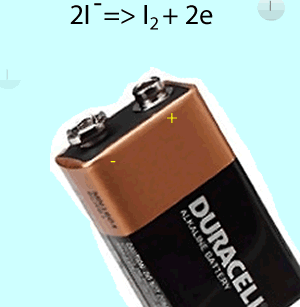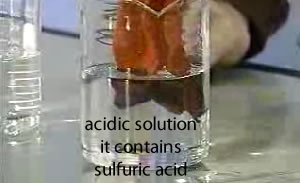The science behind the Blue Battery
Electrical energy can be used to produce a chemical change. This is the first part of our trick involving beaker one. This beaker contains the iodide solution and the starch solution.
By placing the battery in the beaker with the iodide (I- ) a reaction takes place that involves the transfer of electrons. Such reactions are known as redox reactions. Redox reactions are a combination of two reactions, the reaction that gives electrons away, known as the oxidation reaction, and a reaction that takes electrons known as the reduction reaction.
Shown on the right is the reaction that occurs on the positive terminal of the battery which is written as 2I-(aq) => I2(aq) + 2e.
When you read the equation you will see that 2 I- particles form one I2 molecule and give away two electrons. The subscript (aq) indicates that the particles are in solution. In this case both the I- and the I2 are dissolved.

As the I2 is formed it reacts with starch to form a blue coloured solution, as shown on the right. Iodine is often used to identify foods which contain starch.

Pouring the blue solution into beaker 2 makes the blue colour disappear. Something must be happening to the iodine solution to change the colour. This is exactly what happens . The second beaker contains ascorbic acid which is an antioxidant. It is one of the few powerful antioxidants that protect our body from the very reactive free radicals that occur in our body as a result of metabolism and breakdown of pollutants.
A free radical is a molecule or atom that has an unpaired electron. Molecules and atoms like to have paired electrons. This gives them a more stable, low energy state. Otherwise, they become very reactive trying to get rid of one electron or gain one electron.
When vitamin C encounters a free radical in our body it gives the free radical one electron and makes the radical less reactive and also less harmful. However in this reaction vitamin C pulls the iodine molecule apart, the chemistry is a little more complicated than we need to go into here. This changes the solution back to clear.

A little information on free radicals and vitamin C.
Free radicals are formed when bonds split in a way that leaves a molecule with an odd, unpaired electron. However this can only happen under certain conditions. Free radicals are very unstable and react quickly with other compounds, in an attempt to capture one more electron that is needed to gain stability. Free radicals can attack stable molecules, taking there electrons. The molecule under attack loses an electron, it becomes a free radical itself,thus causing a chain reaction that cascades into the eventual death of a the cell. At times it damages the DNA molecule within the cell causing cancer.
Free radicals are not foreign to the body and can occur naturally throughout the metabolic process. However these radicals are mopped up by antioxidants such as vitamin C. . Sometimes the body's immune system creates them in order to destroy viruses and bacteria. Environmental factors such as pollution, radiation, cigarette smoke and herbicides can also create free radicals.
Normally, the body can handle free radicals, but if antioxidants are unavailable, or if the free-radical production becomes excessive, damage can occur. Of particular importance is that free radical damage accumulates with age.
Now for the red rag. Congo red is an indicator that permanently stains cellulose red. A cotton rag is stained with this dye and used for the demonstration. Since cotton is a plant its fibres are made primarily of cellulose.
All plant cells have a very sturdy outer wall called the cell wall, that gives them structural strength and shape.

Congo red is also an indicator. That is it changes colour at a certain pH level. Indicators are a group of chemical compounds that change colour at different pH levels. Different indicators have different pH levels at which they change colour. In an acidic solution Congo red changes to blue, as shown on the right.
However, when placed in a basic solution as happens with beaker 3 the blue cloth will change back to red.
Beaker 4 contains another indicator which turns blue at basic pH levels. So when we squeeze the rag into beaker 4 we actually are squeezing NaOH solution, a very basic substance.

1) Redox reactions involve the giving and taking of
2)
A reaction takes place according to the following equation 2I-(aq) => I2(aq) + 2e. From the equation we can tell that
3) When a battery is placed in water chemical reactions are seen to take place at both terminals.
4) Cellulose is composed of
5) Cellulose is found in
6) Plant cells have a
structure around them, that helps maintain their shape, known as the
7) Which one of the following is true about cellulose?
8) Vitamin C is
9) Free radicals have
10) Which one of the following mops up free radicals in the body?
11) pH is a
12) An indicator is a
13) Free radicals occur naturally in the body
14) The formation of free radicals
in the body can be accelerated by
For senior chemistry only. View the video on the right as the battery is placed in a solution of KI and starch.
What polarity is the terminal producing the white bubbles of gas?
What gas is produced at this terminal?
Write balanced equations for the half reactions that occur at each electrode.
Write the overall equation for this reaction